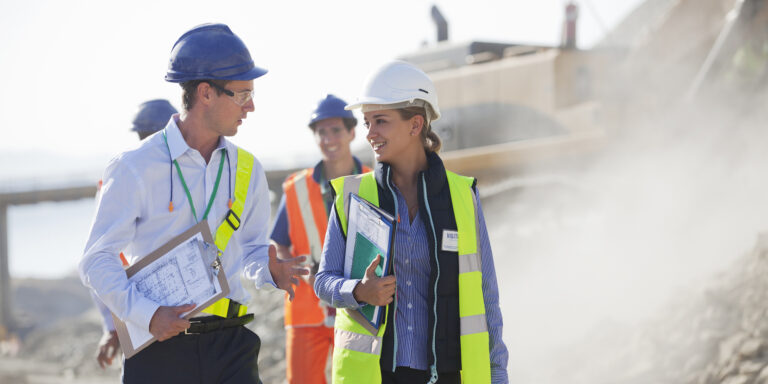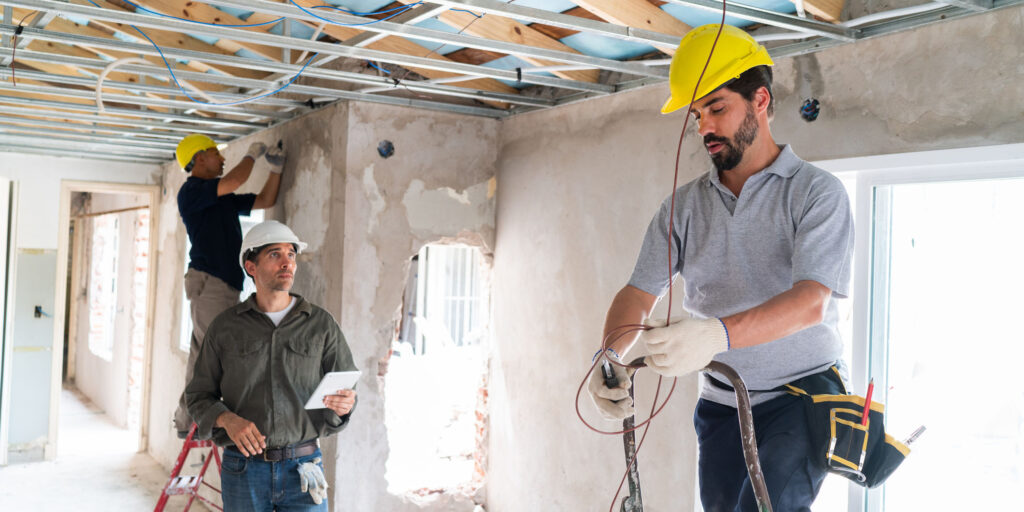— 9 min read
From Forming to Performing: Mastering Communication for a Winning Construction Culture
Last Updated Mar 28, 2025
Last Updated Mar 28, 2025

The way people communicate on a construction site is like the reinforcing steel in a slab—it holds everything together and strengthens the team. Clear, effective communication is essential for building a positive culture and tackling key industry challenges, such as recruiting, training, and retaining skilled workers. It also plays a critical role in managing time, cost, and quality.
On the other hand, poor communication can lead to serious issues, including long working hours, workplace bullying, and a lack of diversity. In a high-risk industry, these factors contribute to poor mental health, taking a significant toll on workers and businesses alike. According to research by BIS Oxford Economics, mental health challenges cost the Australian economy nearly $8 billion per year in lost productivity.
A strong team culture is key to addressing these challenges, but it doesn’t develop through top-down directives alone. While leadership plays an important role, culture is shaped by daily interactions, shared experiences, and, most importantly, how people communicate with one another. Effective communication is what helps teams navigate challenges, resolve conflicts, and build trust—key factors in a high-performance construction environment.
A useful framework for understanding this process is the Tuckman model of team development—“forming, storming, norming, and performing”. Developed by workplace psychologist Bruce Tuckman in 1965, this model outlines how teams evolve over time, and communication plays a critical role at each stage. Whether it’s setting expectations in the forming stage, managing conflicts during storming, reinforcing norms, or collaborating effectively in the performing phase, the way people communicate directly impacts how well a team functions.
We’ll explore each stage of the Tuckman model and how effective communication can help construction teams move through these phases to become stronger, more efficient, and more resilient.
Table of contents
The “Forming” Stage
At this stage, the client, contractor, and project managers assemble the subcontractors and consultants who will deliver the project. While some may have worked together before, many will be new to the team, unfamiliar with the contractor’s and client’s processes, expectations, and ways of working. This phase is about laying the groundwork for clear communication, alignment, and collaboration.
What Communication Needs to Achieve
Pro Tip
Communication at this stage should be clear, direct, and actionable. Make sure all team members fully understand:
Scope & Responsibilities – Clearly outline scope, deliverables and timelines for each works package or consultant’s brief.
Methodologies – Define standards and procedures for each works package.
Health & Safety Expectations – Establish site-specific safety management requirements.
Sustainability Initiatives – Highlight any environmental targets or compliance requirements.
Reporting & Compliance – Clarify what needs to be reported, when, and how.
Project Controls – Ensure everyone understands protocols for variations, extensions of time, financials, and conflict resolution.
People need to become familiar with each other, with the project, and with the contractor and client’s specific methodology, safety and quality expectations.
Early works and enabling works—including site amenities, sign-on arrangements, emergency procedures, power and water setups, and crane/lifting provisions—should be clearly communicated. Tools like diagrams, shared spreadsheets, and detailed drawings can help ensure all team members have the information they need.
Physical site amenities, especially site sheds, can also serve as communication hubs. Strategically placed posters highlighting workplace safety, mental health resources, diversity policies, behavioral expectations, and quality standards can reinforce key messages beyond verbal and written communication.
By setting a strong foundation for communication during the Forming stage, teams can prevent misunderstandings, streamline workflows, and build a culture of accountability from day one.
The “Storming” Stage
Once the sod is turned and work is in full swing, stress levels rise, and personality differences become more apparent. Friction, frustration, and even occasional conflict are to be expected at this stage. How these tensions are managed determines whether they become setbacks or opportunities for growth.
This is where strong leadership is essential. The site manager, project manager, and senior members of subcontracting teams must lead by example, setting the standard for respectful, solution-focused communication.
At its core, this stage is about treating people like human beings, not machines. The words people choose, their tone of voice, and even body language all play a role in fostering a productive and respectful environment.
It is helpful to talk about the Storming stage, especially before it arrives, to let people know it's a normal part of team dynamics, and something the team can work through.
Michelle Stack
Senior Strategic Product Consultant
Procore
Communicating With Early Career Staff
Tensions on-site can be particularly tough on early-career workers. Traditionally, junior staff were often subjected to hazing, teasing, or even outright bullying—practices that contribute to poor mental health and high turnover rates. But this approach does nothing to build a strong, productive team.
Instead, young workers should always have experienced team members backing them up. There should be a clear, site-wide understanding that asking questions is not a weakness—it’s a sign of initiative and a desire to improve.
Young workers need to have people in their corner backing them and making sure that they're not working unsupervised. They should not be expected to know everything straight away.
Michelle Stack
Senior Strategic Product Consultant
Procore
By fostering a culture of respect and support, teams can navigate the challenges of the Storming stage more effectively, setting the foundation for stronger collaboration in the next phase.
Communications With Temporary Workers
Pro Tip
Contractors and labour hire companies should proactively engage with temporary workers to ensure they feel heard and supported. Clear, respectful communication can help prevent alienation and improve both productivity and retention.
Some key strategies include:
Treating temporary workers with the same respect as permanent staff – No double standards.
Providing clear instructions and expectations – Avoid last-minute, vague directives.
Gathering feedback from labour hire workers – Regular check-ins help identify concerns early.
Recognising effort and contribution – A simple acknowledgment can go a long way.
Labour hire workers often experience the toughest conditions on-site, despite playing a critical role in project delivery. Since they are usually brought in after the initial team-building phase, they may not receive the same level of onboarding or respect as permanent team members. In many cases, they are given the toughest jobs in terms of brute effort
When temporary workers are treated like expendable labour rather than valued team members, morale and performance suffer. Without proper recognition or fair treatment, there is little incentive for them to go above and beyond.
At the end of the day, good communication is about treating all workers—regardless of contract status—with the same level of professionalism and respect. A well-integrated workforce is a more productive and motivated one.
The “Norming” Stage
With the team now familiar with each other, maintaining clear and effective communication is essential to keep everything—and everyone—on track. A mix of written, digital, verbal, and visual communication is needed to ensure consistency across:
- Quality - through Site walk, inspections and defect recording
- Scope Changes - managed through RFIs and variations
- Timing - through Scheduling, Progress tracking and reporting
- Safety - through Inductions, Toolbox meetings and site walks
The Power of Visual Communication
Pro Tip
For any communication, whether verbal, written or visual, keep in mind that construction is a highly practical business, and most people will not appreciate any additional corporate-speak. Keep it:
Direct – Stick to the facts.
Actionable – Be specific about what needs to be done.
Verifiable – Encourage workers to ask for clarification or confirm understanding through reverse briefing.
Using drawings, even quick sketches, can also be a very valuable tool for ensuring communication on mission-critical matters is understood. This can also help overcome any language barriers, or literacy issues.
Giving people more context to their work is extremely valuable, as it also enhances everyone’s ability to identify potential issues and come up with sound solutions. Using the “show and tell” strategy is also important, as everyone learns differently. So, backing up verbal communication with written including drawings is more likely to get important information across.
Leveraging Technology for Smarter Communication
Digital construction platforms help centralise communication and keep project teams aligned. With real-time access to project documents, drawings, and schedules, teams can:
- Plan ahead – Workers can review upcoming tasks and prepare accordingly.
- Ask better questions – Having access to the latest information helps teams identify what they need to clarify and who to ask.
- Reduce errors – Ensuring everyone is working from the most current set of drawings and instructions minimises rework and confusion.
By combining strong communication practices with the right technology, teams can stay informed, aligned, and focused on delivering a successful project.
The “Performing” Stage
It is very important to celebrate and recognise progress, not just at major milestones like topping out, but throughout the project.
Simple initiatives like a site BBQ to mark a key stage, sharing positive feedback, and acknowledging when individuals go above and beyond help build trust and a sense of shared achievement.
The long hours involved on many projects, particularly for time-sensitive works such as concrete pours, can also be recompensed with time in lieu. This kind of reward is another form of communication in that it tells workers their efforts are appreciated and reinforces the sense that the project’s management sees them as human beings with a life outside of work that also deserves some time.
Everyone likes to know that somebody is caring for them, and they don't want to have to ask to be cared for, so to do something that's considerate will mean a lot to them.
Culture is always a work in progress.
A strong team culture isn’t “set and forget.” Even when a project is running smoothly, it’s important to remain vigilant—checking in on colleagues, ensuring standards are upheld, and speaking up when something doesn’t seem right. This ongoing effort is also crucial for managing mental health risks, which can arise at any stage of a project.
Everyone should have someone that's checking in on them and knows exactly where they're at, and observing the behaviours around that, and making sure that if someone's not being treated appropriately to their role, or their knowledge, then say something, point it out.
Michelle Stack
Senior Strategic Product Consultant
Procore
One of the most rewarding outcomes of investing in communication and building a strong team culture is being able to carry that success forward into the next project. Many successful builders, having worked through the "forming, storming, norming, and performing" stages with subcontractors who delivered the project safely, on time, and to a high standard, are eager to collaborate with those same teams again.
For individual workers, understanding the stages of team culture, knowing what to expect at each phase, and learning how to communicate effectively reduces stress and helps everyone stay focused on delivering a great outcome. When communication is clear and team culture is strong, not only are projects more successful, but careers are, too.
Categories:
Tags:
Written by
Michelle Stack
10 articles
Michelle Stack is a Senior Strategic Product Consultant at Procore, bringing over 20 years of experience in project management, IT solutions, and change transformation. For 7 years, she has led technology change in the construction industry working closely with teams in design and construction through to post completion. Throughout her career, Michelle has successfully aligned operations with organisational strategies, ensuring changes are implemented through clear communication, training, and evaluation. Her extensive expertise has made her a trusted leader in driving effective, sustainable transformations.
View profileExplore more helpful resources

Construction Document Management: The Challenges and Benefits of Embracing a DMS
Every construction project begins, continues, and ends with a mountain of paperwork. From initial bidding documents to contractor agreements, blueprints, variation orders, inspection reports, on and on it goes. And...

Cash Flow Forecasting in Construction: How to Stay Ahead of Funding Gaps and Protect Project Performance
Cash shortfalls are a leading cause of stalled projects, unpaid contractors, and budget blowouts in construction. Without a clear forecast of how cash will flow in and out over time,...

Construction Handover: The Keys to a Smooth and Successful Transition
Project handover should be a seamless transition, but its success is determined long before the last walkthrough. When teams consistently align on design, timelines, and quality, and support that alignment...

Cutting Delays and Costs: Proven Ways to Boost Construction Site Efficiency
On-site efficiency separates profitable construction projects from those plagued by delays and budget overruns. In Australia’s construction landscape—where supply chain disruptions, skilled labour shortages, and increasingly strict regulations are the...